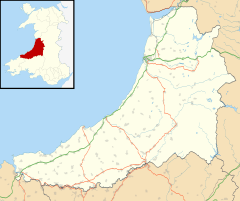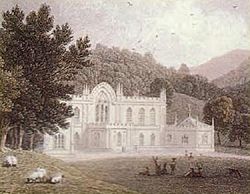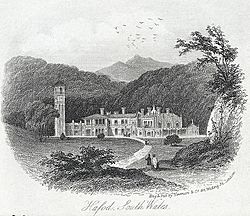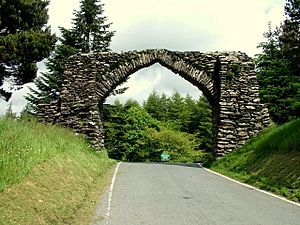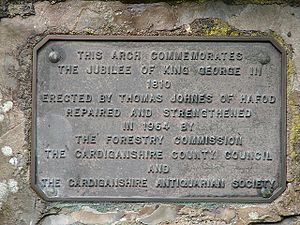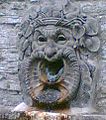Hafod Uchtryd facts for kids
Quick facts for kids Hafod Estate
|
|
|---|---|
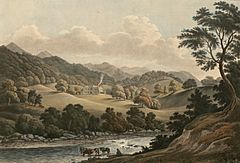 A depiction of the Hafod Estate, circa 1795 by John Warwick Smith |
|
| OS grid reference | SN6676 |
| • Cardiff | 90 mi (140 km)SE |
| Principal area | |
| Ceremonial county | |
| Country | Wales |
| Sovereign state | United Kingdom |
| Post town | ABERYSTWYTH |
| Postcode district | SY23 |
| Dialling code | 01970 |
| Police | Dyfed-Powys |
| Fire | Mid and West Wales |
| Ambulance | Welsh |
| EU Parliament | Wales |
| UK Parliament |
|
| Welsh Assembly |
|
Hafod Uchtryd (which means "Uchtryd summer mansion" in English) is a beautiful estate with lots of trees and planned gardens. It's located in the Ystwyth valley in Ceredigion, Wales. You can find it near Devil's Bridge, Cwmystwyth, and Pont-rhyd-y-groes, just off the B4574 road.
Long ago, the land of Hafod Uchtryd was part of the Cistercian Abbey called Strata Florida. It started as a hunting lodge for Welsh Chieftains. Later, it became home to important families and nobles. In the late 1700s, a famous landscape was created here by its owner, Thomas Johnes.
The estate is in the area of Llanfihangel y Creuddyn, close to Llanddewi-Brefi. The church there was rebuilt for Thomas Johnes in 1801. Hafod shares a border along the Ystwyth River with the Trawsgoed estate.
Contents
A Look Back: Hafod's Early Days
After King Henry VIII closed down the monasteries in the 1500s, their lands were split up. New owners took over. Some of the Strata Florida lands went to the Herbert family. They arrived in Ceredigion when Elizabeth I was queen. Sir Richard Herbert was a high-ranking official in Cardigan in 1542.
Records from 1540 show that William and Morgan Herbert rented several properties that used to belong to Strata Florida Abbey. One of these was Hafod Uchtryd, which became the name of the main house and its surrounding land.
The estate became very well-known in the late 1700s. This was when its owner, Thomas Johnes (1748-1816), made it a perfect example of the "Picturesque" style of landscape. This style aimed to create natural-looking, beautiful scenes that were like paintings. Many visitors wrote about and drew pictures of the estate and its Gothic-style house.
Johnes' Amazing Mansion
Thomas Johnes built a brand new mansion at Hafod in 1785. He tore down the old Herbert building. The new house was designed by Thomas Baldwin from Bath in the Gothic style.
The mansion had a large, eight-sided library. Johnes loved books and collected many rare ones. He had books on natural history and old writings in Welsh, French, and Latin. He even bought a huge book collection from the Marquis de Pesaro.
A special sculpture by Thomas Banks stood in the library. It showed Thetis dipping her son Achilles into the river Styx. Johnes' wife, Jane, asked for this sculpture to be made. The head of Achilles in the sculpture looks like their baby daughter, Mariamne. Today, you can see this sculpture at the Victoria and Albert Museum.
Next to the library was a very long conservatory, about 160 feet (49 m) long. It was filled with many different rare plants.
Art and Treasures Inside
The mansion was full of amazing artworks. In the dining room, there was a painting by Peter Paul Rubens. It showed Decius Mus receiving a blessing. Another painting, The prophet Elijah fed by the ravens, used to be in an abbey.
The house also had portraits by famous artists like Sir Godfrey Kneller. There were landscapes by Both and Berghem. In the drawing-room, you could see Hogarth's famous picture of Southwark Fair. There was also a Descent from the Cross by Van Dyck. Other artworks included paintings by Claude and Canaletti. Mariamne Johnes, their daughter, even had some beautiful miniature paintings on display.
The main hall was made of special Mona marble. It had a Grecian statue of Dionysus. There were also six paintings showing scenes from old French stories by Froissart.
The Fire and Rebuilding
On March 13, 1807, a terrible fire broke out. It completely destroyed the mansion, including all the precious books in the library. Johnes was in London at the time. He was relieved to hear that his wife and daughter had escaped safely.
The family moved to a rented house near Aberystwyth. Johnes hired Baldwin of Bath again to rebuild the mansion. Construction started on September 1, Johnes' birthday, that same year. The builders promised to finish the roof by Christmas.
Johnes began replacing the items for his home. He bought many furnishings from a grand house called Fonthill Splendens. These included French glass doors and several beautiful fireplace mantels. One mantelpiece had a sculpture by Banks showing two couples: Pan and Iris, and Penelope and Odysseus. These items were stored until the mansion was ready.
The family traveled while the house was being built. But when they returned each year, it was still not finished. Johnes finally stayed in Wales and visited the site weekly to watch the progress himself. The whole rebuilding project took three years to complete.
Hafod's Golden Years

The years between 1790 and 1810 were the best for Hafod. Colonel Thomas Johnes, the estate owner, planted a huge number of trees. He planted about 405 to 485 hectares (1000-1200 acres) of forest. Most of these were Larch and Scots Pine trees on the higher ground. He planted oak and beech trees in the lower, richer areas.
In 1798, the Duke of Norfolk visited the estate. He was the head of the Royal Society of Arts (RSA). He encouraged Johnes to enter their awards for tree planting. Johnes won five Gold Medals from the Society for his amazing work:
- 1800: For planting Larch trees.
- 1801: For planting and enclosing timber trees.
- 1802: Again, for planting and enclosing timber trees.
- 1805: For his Oak tree plantations.
- 1810: For his Larch and other tree plantations.
Colonel Johnes planted about three million trees on the estate during his time there!
Farming and Helping the Community
Johnes also set up an experimental farm at Hafod called New Farm (or Gelmast in Welsh). It had a large dairy. People thought the land around Hafod couldn't support dairy farming. But in 1800, Johnes produced about four tons of cheese and 1,200 pounds (540 kg) of butter!
He tried different types of cows to see which gave the most milk. He even brought 40 cows from the Netherlands, calling them his "Dutch ladies." He was able to make different kinds of cheese, like Parmesan, Stilton, Cheshire, and Gloucestershire cheese, right from his own dairy.
Johnes cared a lot about the people living at Hafod. He worked hard to build roads and bridges. When he first took over the estate, there were no good roads at all. In 1810, he built Hafod Arch to celebrate 50 years of King George III's rule.
He also built a school where poor children could learn for free. He created a fund to help families who faced difficulties. A doctor was hired, and medicine was provided to the community. Every Christmas, he and Mrs. Johnes opened their home for a big celebration with everyone from Hafod.
Who Owned Hafod Later?
After Thomas Johnes, Hafod had several different owners:
- On March 13, 1833, the Duke of Newcastle bought the estate.
- In 1846, it was sold to Sir Henry de Hoghton.
- On June 1, 1857, William Chambers bought Hafod.
- On April 27, 1871, Lady Willoughby sold the estate to John Waddingham.
- From 1890 to 1940, Thomas James Waddingham owned Hafod. He loved Wales and learned Welsh. He was involved in local life. He leased part of the estate, Myherin Forest, to the Forestry Commission in 1929.
- Between 1940 and 1946, Hafod changed hands three more times.
The Mansion's End
The mansion was empty by 1946. By 1958, the house was falling apart, so it was torn down that year. Today, only the old stables remain. They are now used as the estate offices. There's also a large pile of rubble where the house once stood. Some other small buildings and cottages are still there. You can even rent one for a holiday!
Hafod Today
Today, the Hafod estate covers about 200 hectares of the Ystwyth valley and the hills around it. Most of it is owned by Natural Resources Wales. They work with the Hafod Trust to protect and restore the estate. They use money from public and private sources. In 1998, the Hafod Estate received a grant of £330,000 to help with this work.
The estate has staff who manage the conservation projects. They also have craftspeople to ensure the work is done very well.
Visitors today can follow many marked walking paths that show off the "Spirit of Place" at Hafod. The estate is popular with tourists who want to enjoy some of the most beautiful views and pleasant walks in Wales. The walks have fun names like 'The Gentleman’s Walk' and 'The Alpine Bridge Walk.' The grassy areas around the old house ruins are home to many different kinds of fungi, especially waxcaps. This makes it one of the best places in the UK to see these fungi.
Images for kids


